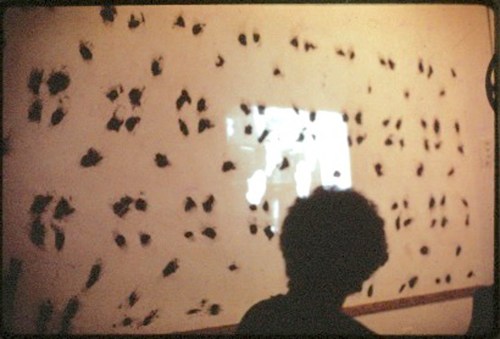
Finch College Project, 1969, by Robert Morris is an installation which consists of a film projected in the same site where it was created. It is a significant precursor to the immersive video installations that gained prominence as a medium for avant-garde art during the 1970s. This project constitutes a continuation of Morris’s earlier interest in installations that produce a total environment, as in his 1961 work, Untitled (Passageway). In 2001, the Whitney Museum of American Art included Finch College Project in the exhibition Into the Light: The Projected Image in American Art 1964–1977, placing this piece in conversation with similar moving-image installations created by artists such as Vito Acconci, Simone Forti, Dan Graham, and Joan Jonas.
The project is realized in two phases. In the first phase, a film camera is placed on a turntable in the center of the exhibition space. As it revolves, the camera records a crew of people installing a mural-sized photograph of an audience in a movie theater on one wall and a mirror of equal size on the opposite wall. The photograph and the mirror each consist of a grid of 28 pieces. Immediately after the installation is completed, the mirror and the photograph are removed, leaving behind scratches and glue-residue on the walls.
In the second phase, a projector is placed on the turntable and the film of the crew installing the photograph and mirror is projected onto the walls of the exhibition space, where the traces of these objects remain.
The work invites viewers to contemplate the complex web of performance and spectatorship they find themselves immersed in. The presence of these different gazes and bodies that crisscross both time and space seem palpably registered by the marks left on the wall. Spectators in the present piece together a history of the space through the physical traces left on the wall and the film record being projected over it.